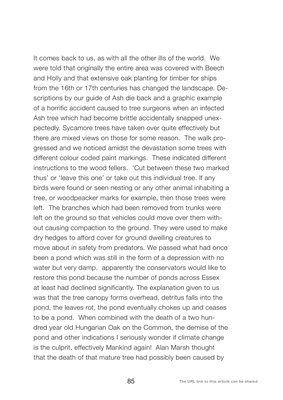
85
It comes back to us, as with all the other ills of the world. We
were told that originally the entire area was covered with Beech
and Holly and that extensive oak planting for timber for ships
from the 16th or 17th centuries has changed the landscape. Descriptions
by our guide of Ash die back and a graphic example
of a horrific accident caused to tree surgeons when an infected
Ash tree which had become brittle accidentally snapped unexpectedly.
Sycamore trees have taken over quite effectively but
there are mixed views on those for some reason. The walk progressed
and we noticed amidst the devastation some trees with
different colour coded paint markings. These indicated different
instructions to the wood fellers. 'Cut between these two marked
thus' or 'leave this one' or take out this individual tree. If any
birds were found or seen nesting or any other animal inhabiting a
tree, or woodpeacker marks for example, then those trees were
left. The branches which had been removed from trunks were
left on the ground so that vehicles could move over them without
causing compaction to the ground. They were used to make
dry hedges to afford cover for ground dwelling creatures to
move about in safety from predators. We passed what had once
been a pond which was still in the form of a depression with no
water but very damp. apparently the conservators would like to
restore this pond because the number of ponds across Essex
at least had declined significantly. The explanation given to us
was that the tree canopy forms overhead, detritus falls into the
pond, the leaves rot, the pond eventually chokes up and ceases
to be a pond. When combined with the death of a two hundred
year old Hungarian Oak on the Common, the demise of the
pond and other indications I seriously wonder if climate change
is the culprit, effectively Mankind again! Alan Marsh thought
that the death of that mature tree had possibly been caused by
The URL link to this article can be shared